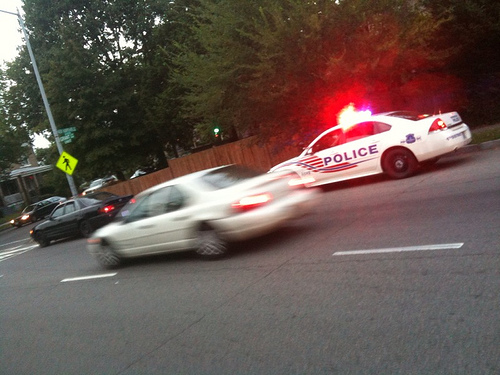DC may raise traffic fines. Criminology says that’s unhelpful.
DC’s new plan for Vision Zero, the effort to reduce road deaths to zero, contains significant steps forward like lowering some speed limits and trying out protected intersections. It also raises some fines by 350% to 1000%. Is that wise? I’m not convinced.
Here are some of the old and new fines:
| Offense | Old fine | New fine |
|---|---|---|
| Speeding 26+ mph over the speed limit | $350 | $1,000 |
| Not yielding to a bus | None | $500 |
| Not stopping at a stop sign | $50 | $100 |
| Not yielding to a pedestrian when turning right on red | $50 | $200 |
| Parking in a bike lane (private car) | $65 | $200 |
| Parking in a bike lane (commercial vehicle) | $65 | $300 |
| Dooring a cyclist | $25 | $100 |
| Striking a cyclist | $50 | $500 |
Some of these are pretty egregious. To drive more than 26 mph over the speed limit, for instance, means going over 55 in a 30 mph zone. That’s fast. Striking a cyclist, of course, is a horrible thing to do, even if drivers almost always don’t mean to.
Some of these, though, represent everyday, if dangerous, behaviors. People turn right on red without yielding to pedestrians or fail to yield to buses pulling into traffic all the time, though they shouldn’t. Will the news of a multi-hundred-dollar fine jolt people into thinking twice about these actions?
The goal here is to change people’s everyday behavior — to get them to realize that when a bus is trying to get into traffic, or when a person is crossing at a crosswalk, that it’s wrong to try to pass the bus before it merges in or turn right without waiting for the person to finish crossing.
What criminology can teach us about traffic safety
There’s more research about changing behavior when it comes to lower-level criminal offenses, like drug dealing. UCLA law NYU public policy professor Mark Kleiman has demonstrated that “swift, certain, and fair” penalties — when most offenders get caught quickly but face lower punishments — have far greater effect of changing behavior than large but rarely-imposed ones.
In traffic enforcement, it’s currently true that almost none of the people who run stop signs, turn right on red illegally, speed, park in bike lanes, etc. get caught. Cranking up the fine but not raising the certainty of catching offenders seems to be falling into the same trap as when lawmakers lengthened prison sentences. They didn’t stop drug dealing, but did end up incarcerating a huge proportion of the American population at great cost to taxpayers and to society.
I asked Kleiman on Twitter about the fine proposal. He, and DC Councilmember David Grosso, don’t think they will work:
@alpert @maustermuhle @MarkARKleiman @MartinDiCaro @wamu885news Mega high fines are not as effective as many more small fines.
— David Grosso (@cmdgrosso) December 9, 20151. $1k is absurd.
2. Smaller penalties collected more often work better.
3. Fines should be proportioned to income. https://t.co/P219xPI0Cu
— Mark A.R. Kleiman (@MarkARKleiman) December 10, 2015
What’s that third point? Make fines proportional to income? It’s an interesting idea which Finland and several other European countries use. The “day fine” charges people some proportion of what they might make in a day, or a week, or a month.
There’s a real danger that high fines will end up pulling even more money from poor communities, just as we’ve seen in places like Ferguson, Missouri. As Adonia Lugo has written, there’s also the danger that greater enforcement by police will just exacerbate existing racial bias.
Black and white people use marijuana at nearly equal rates, but black people are (or were in 2013, anyway) eight times as likely to get arrested for marijuana in DC as white people. Will $500 fines for not yielding to buses be different?
Correction: The initial version of this post incorrectly listed Professor Mark Kleiman’s affiliation as UCLA. He was formerly with UCLA but is now at NYU. Also, he is a professor of public policy, not law.
This is part 1 in a 3-part series. Read the next part about how traffic cameras could make enforcement swift, certain, and fair.

